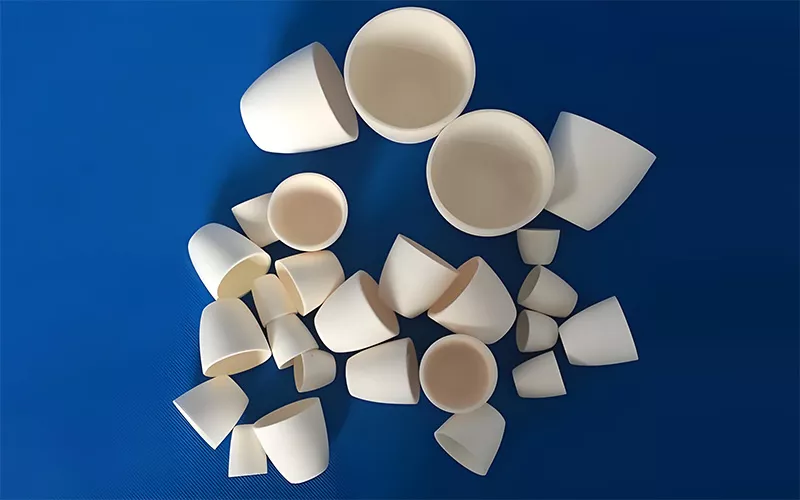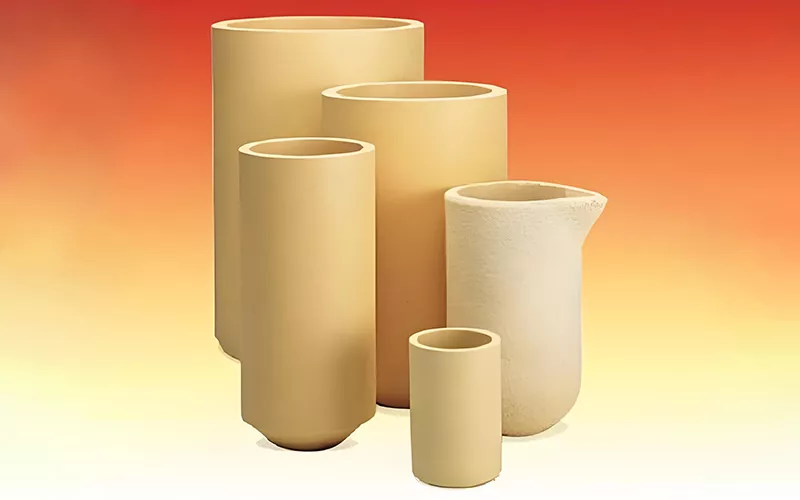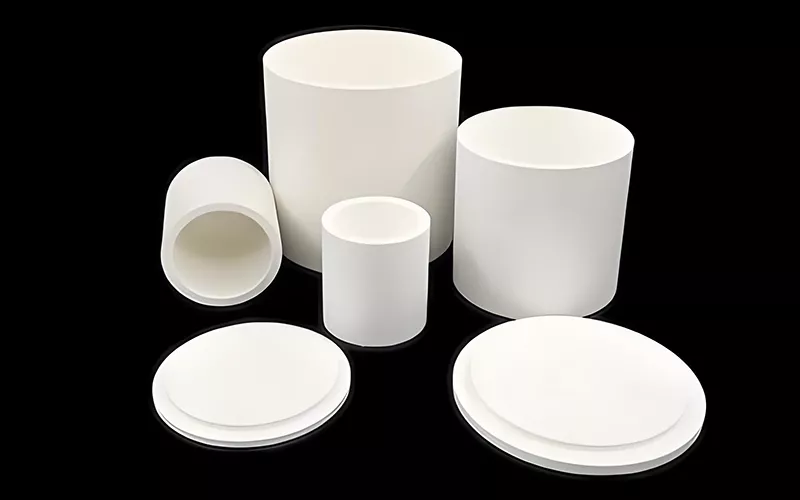Ceramic crucibles are containers with high melting points and high temperature resistance. They combine chemical stability with a low coefficient of thermal expansion, making them essential tools for extremely high-temperature applications in laboratories, metallurgy, semiconductor manufacturing, and other fields.
Ceramic crucibles are primarily made from advanced ceramics such as alúmina, nitruro de boro, y óxido de circonio. In this article, we’ll explore ceramic crucible material selection, key characteristics, and service life to help you select the most suitable crucible for your high-temperature application.

¿Cuáles son los materiales del crisol de cerámica?
Crisol de alúmina
Crisoles cerámicos de alúmina are primarily made of 99.7% pure aluminum oxide. Did you know? During the production process, many manufacturers, such as GORGEOUS, add small amounts of magnesium oxide (MgO) and silicon dioxide (SiO2) to impart superior physical and chemical properties to the crucibles.
Key Features: High-Temperature Resistance - Alumina crucibles can withstand temperatures of approximately 1700°C in a redox atmosphere. While offering superior performance, alumina crucibles are also price-competitive, making them the preferred material for many manufacturers.
Applications: Alumina crucibles are primarily used in laboratory and industrial metallurgy, heating, and chemical reactions.
Advantages: Alumina crucibles are one of the most economical ceramic crucibles on the market. Alumina’s high melting point and low thermal expansion coefficient make them resistant to cracking. They are ideal reaction vessels for weakly alkaline substances.
Limitations: Strongly corrosive substances, such as the strong base sodium hydroxide (NaOH), can severely damage alumina crucibles. For these materials, GORGEOUS recommends using a crucible material with strong corrosion resistance instead of alumina crucible.
Crisol de zirconia
Zirconia crucibles are primarily made of high-purity zirconium oxide. Their exceptionally high temperature resistance and chemical stability make them ideal for extremely high-temperature melting processes.
Key Features: Zirconia crucibles boast robust high-temperature resistance, capable of withstanding temperatures up to 2000°C, making them ideal for melting precious metals such as platinum (Pt) and palladium (Pd).
Zirconium oxide also possesses excellent chemical resistance, maintaining a stable structure even in harsh environments with strong acids and alkalis, making it an ideal crucible material for processes prone to corrosion.
Applications: Zirconia crucibles are primarily used in precious metal melting and certain processes involving high-melting-point materials.
Crisol de alúmina endurecida con zirconio (crisol ZTA)
Zirconia-toughened alumina crucibles (ZTA) are primarily made of 90% alumina and 10% zirconia. This ceramic material combines the advantages of both alumina and zirconia, offering excellent high-temperature resistance and high toughness.
Key Features:
High Toughness - The addition of zirconia significantly improves the crucible’s crack and wear resistance, reducing damage caused by high temperatures and mechanical shock.
High-Temperature Resistance - ZTA crucibles can withstand temperatures up to 1700°C and operate stably in high-temperature environments.
Thermal Shock Resistance - Compared to pure alumina crucibles, ZTA crucibles offer higher thermal shock resistance, are more stable under severe temperature fluctuations, and are less prone to cracking.
Applications: These crucibles are primarily used in processes requiring high mechanical strength and high-temperature stability.
Crisol de nitruro de boro (crisol PBN)
Boron nitride crucibles are specially designed for use at extremely high temperatures. Their primary component is pyrolytic boron nitride.
Key Features:
High-Temperature Resistance - Boron nitride crucibles offer exceptional high-temperature resistance. In a protective atmosphere, they can reach temperatures of up to 2100°C and remain stable. They will not melt or react chemically with the substrate at extremely high temperatures.
Thermal Conductivity - Boron nitride crucibles have excellent thermal conductivity, allowing them to quickly dissipate heat, effectively preventing localized overheating, thermal stress, and thermal damage.
Low Thermal Expansion Coefficient - Boron nitride has a low thermal expansion coefficient, effectively reducing the risk of crucible cracking in high-temperature processes requiring rapid cooling or heating.
Applications: Boron nitride crucibles are primarily used in high-temperature processes such as semiconductor manufacturing and metal smelting. In the semiconductor industry, they are often used in chemical vapor deposition (CVD), crystal growth, and high-temperature evaporation.
Otros materiales cerámicos
Además de los materiales cerámicos comunes mencionados anteriormente, también existen materiales de crisol de alta calidad, como el óxido de magnesio y el óxido de berilio. Todos ellos ofrecen un excelente rendimiento a altas temperaturas y son esenciales para los recipientes de crisol de muchos laboratorios y fundiciones de metales.
¿Cómo garantizar la vida útil del crisol?
If you want your crucible to have better performance and service life, you’d better do the following:
Almacenamiento:
Es mejor almacenar los crisoles usados en un ambiente seco y limpio para evitar que absorban humedad y se contaminen. Se debe evitar almacenarlos cerca de productos químicos o en zonas con alta humedad.
Funcionar:
Debe utilizar herramientas adecuadas para operar el crisol, evitar el contacto directo con las manos y verificar si tiene grietas o daños después de su uso.
Limpieza:
Limpie el crisol a fondo después de cada uso. Retire todos los residuos y deje que se enfríe completamente antes de limpiarlo para evitar choques térmicos y grietas.
Preguntas frecuentes
1. ¿Qué es un crisol?
Un crisol es un recipiente diseñado para su uso a temperaturas extremadamente altas, utilizado principalmente para la fundición de metales y reacciones químicas.
2. ¿Cuál es el punto de fusión de un crisol cerámico?
El punto de fusión de un crisol cerámico depende principalmente del material utilizado. Por ejemplo, un crisol de alúmina puede soportar temperaturas de entre 1650 °C y 1700 °C, mientras que un crisol de zirconio puede soportar temperaturas de hasta 2000 °C.
3. ¿Cuáles son los usos de los crisoles cerámicos en química?
Los crisoles cerámicos se utilizan a menudo para la fundición de metales a alta temperatura, como contenedores de reacción química, contenedores de procesamiento de materiales, etc.
4. ¿Cuál es la función del crisol cerámico?
El crisol cerámico se utiliza principalmente para aplicaciones de calentamiento a alta temperatura, fusión o refinamiento de materiales, etc. También puede actuar como contenedor para algunas reacciones químicas.
5. ¿Cuáles son las propiedades materiales de los crisoles cerámicos?
Los materiales cerámicos tienen las características de alto punto de fusión, bajo coeficiente de expansión térmica, buena estabilidad térmica y resistencia a la corrosión química.
6. ¿Se pueden utilizar crisoles cerámicos para fundir sustancias alcalinas fuertes?
Esto depende principalmente del material del crisol. Generalmente, no recomendamos usar crisoles de alúmina para fundir sustancias alcalinas fuertes como el hidróxido de sodio (NaOH) y el peróxido de sodio (Na₂O₂), ya que estas sustancias pueden corroer el crisol.
7. ¿Cuál es la diferencia entre un crisol de porcelana y un crisol de cerámica?
El crisol de porcelana se refiere generalmente a un crisol hecho de porcelana. El crisol de cerámica ofrece un rendimiento superior al crisol de porcelana tradicional, soporta temperaturas más altas y posee propiedades mecánicas más robustas.
8. ¿Cómo calentar un crisol cerámico?
Al calentar un crisol cerámico, se debe elegir un método de calentamiento adecuado según las características del material. Es importante evitar el enfriamiento o calentamiento repentino durante el calentamiento, ya que podría agrietarse.
9. ¿Cuáles son los métodos de mantenimiento de los crisoles cerámicos?
Después de usar el crisol, debe limpiarlo completamente para eliminar los residuos, utilizar una solución de limpieza adecuada para limpiarlo y, finalmente, enjuagarlo con agua pura y secarlo para su uso posterior.
Conclusión
Ceramic crucibles are indispensable tools in modern chemistry and metallurgy. Capable of operating in extreme temperatures and harsh chemical environments, they play a key role in a wide range of scientific and industrial applications. GORGEOUS, a leading international supplier of advanced ceramics, offers custom-made ceramic crucibles in a variety of materials. Thank you for reading this article, and we hope you find it helpful.